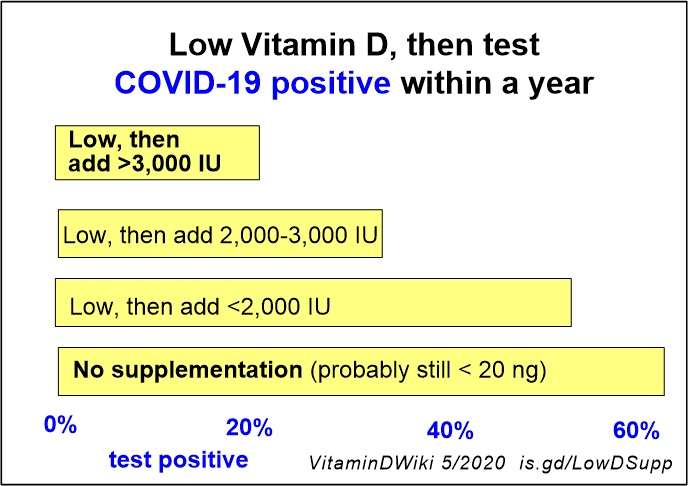Low Vitamin D increased chance of COVID-19, unless supplement
Association of Vitamin D Deficiency and Treatment with COVID-19 Incidence
David O Meltzer dmeltzer@medicine.bsd.uchicago.edu, Thomas J Best, Hui Zhang, Tamara Vokes, Vineet Arora, Julian Solway
doi: https://doi.org/10.1101/2020.05.08.20095893
This article is a preprint and has not been certified by peer review.
It reports new medical research that has yet to be evaluated and so should not be used to guide clinical practice.

Data for the chart comes from table 4

Peer- reviewed publication COVID-19 1.77X less likely if more than 20 ng of vitamin D (489 people) – JAMA Sept 2020
📄 Download the PDF from VitaminDWiki
Importance: Vitamin D treatment has been found to decrease incidence of viral respiratory tract infection, especially in vitamin D deficiency. It is unknown whether COVID-19 incidence is associated with vitamin D deficiency and treatment.
Objective: To examine whether vitamin D deficiency and treatment are associated with testing positive for COVID-19. Design: Retrospective cohort study Setting: University of Chicago Medicine Participants: Patients tested for COVID-19 from 3/3/2020-4/10/2020. Vitamin D deficiency was defined by the most recent 25-hydroxycholecalciferol <20ng/ml or 1,25-dihydroxycholecalciferol <18pg/ml within 1 year before COVID-19 testing. Treatment was defined by the most recent vitamin D type and dose, and treatment changes between the time of the most recent vitamin D level and time of COVID-19 testing. Vitamin D deficiency and treatment changes were combined to categorize vitamin D status at the time of COVID-19 testing as likely deficient(last-level-deficient/treatment-not-increased), likely sufficient(last-level-not-deficient/treatment-not-decreased), or uncertain deficiency(last-level-deficient/treatment-increased or last-level-not-deficient/treatment-decreased).
Main Outcomes and Measures: The main outcome was testing positive for COVID-19. Multivariable analysis tested whether the most recent vitamin D level and treatment changes after that level were associated with testing positive for COVID-19 controlling for demographic and comorbidity indicators. Bivariate analyses of associations of treatment with vitamin D deficiency and COVID-19 were performed.
Results: Among 4,314 patients tested for COVID-19, 499 had a vitamin D level in the year before testing. Vitamin D status at the time of COVID-19 testing was categorized as likely deficient for 127(25%) patients, likely sufficient for 291(58%) patients, and uncertain for 81(16%) patients. In multivariate analysis, testing positive for COVID-19 was associated with increasing age (RR(age<50)=1.05, p<0.021; RR(age≥50)=1.02,p<0.064)), non-white race(RR=2.54,p<0.01) and being likely vitamin D deficient (deficient/treatment-not-increased: RR=1.77,p<0.02) as compared to likely vitamin D sufficient(not-deficient/treatment-not-decreased), with predicted COVID-19 rates in the vitamin D deficient group of 21.6%(95%CI[14.0%-29.2%] ) versus 12.2%(95%CI[8.9%-15.4%]) in the vitamin D sufficient group. Vitamin D deficiency declined with increasing vitamin D dose, especially of vitamin D3. Vitamin D dose was not significantly associated with testing positive for COVID-19.
Conclusions and Relevance: Vitamin D deficiency that is not sufficiently treated is associated with COVID-19 risk. Testing and treatment for vitamin D deficiency to address COVID-19 warrant aggressive pursuit and study.
COVID-19 treated by Vitamin D - studies, reports, videos
- {include}
